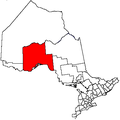History
The mouth of the Pic River has been a center of native trade and settlement for thousands of years. It was a strategic location in the region's water transportation network because it offered access to northern lands and a canoe route to James Bay. The halfway point for canoers travelling the north shore of Lake Superior, "the Pic" first appeared on European maps in the mid-seventeenth century.
Local First Nations peoples traded furs with the French as early as the 1770s. A French fur trader set up a permanent post around 1792. The Hudson's Bay Company set up a permanent post in 1821 until encroaching settlement let to its relocation in 1888. In 1914, their Pic River 50 became a treaty-established reserve.
Reserve
Pic River 50 is an Indian reserve on the north shore of Lake Superior at the mouth of the Pic River, near Marathon, Ontario, Canada. The reserve is 316.6 ha within its exterior boundaries, and serves as the land-base for the Ojibways of the Pic River First Nation. In November, 2007, the First Nation reported their total registered population was 964 people, of which their on-reserve population was 480.
Pic River 50 is known for the role it has played in developing "run of the river" hydroelectric projects in Northern Ontario. It is partner to three projects: the 13.5 MW Wawatay generating station (GS) on the Black River, the 5.0 MW Twin Falls GS and the 23.0 MW Umbata Falls GS. In all, these projects produce enough electricity to meet the needs of some 30,000 homes in Ontario.
Ojibways of the Pic River First Nation are currently attempting to create a self-sustainable reserve with employment, education and resources being developed and used within the reserve itself. Thus far, Pic River 50 has a thriving forestry company, a cable television company and a high speed internet company.
The Pic River 50 reserve is home to many wild Northern Ontario species such as the beaver, moose, woodland caribou, wolf, black bear, white tailed and red tailed hawk, bald eagle, northern flicker, and many arctic alpine plants. The shores of Pic River 50 are dominated by the mass sandy dunes on the Little Pic river, which translates to "little muddy."
This page is based on this
Wikipedia article Text is available under the
CC BY-SA 4.0 license; additional terms may apply.
Images, videos and audio are available under their respective licenses.


